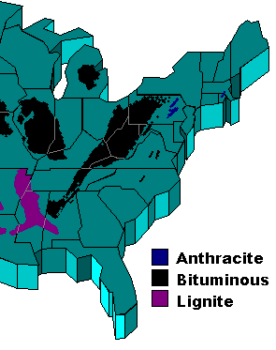by Dan Bourque
Coal, or “black diamonds,” has been an integral part of railroad operations for well over a century, and if you intend to model an Appalachian railroad, chances are you’ll be modeling a lot of coal! Learning some simple facts about coal goes a long way towards helping you model it.
In simple terms, coal is formed from dead vegetation pressurized under layers of rock and dirt over thousands of years. Coal comes in many different forms including lignite, bituminous, and anthracite. The form that coal takes is based on the length of time the coal has been forming and the amount of pressure applied during formation. The different forms have many different properties.
Types of Coal
 The simplest form of coal is lignite or “brown coal.” Lignite is much softer than the other forms of coal and is typically found in the Western US. One of the largest areas for lignite mining is the Powder River Basin in Wyoming. Lignite tends to smear on touch and may be easy to crumble. When compared to other coals, lignite is more dull in appearance. There are many benefits of lignite. It is easy to mine, low in sulphur (an undesirable pollutant), and cheap! The downside is that it produces much less energy (measured in BTUs) per ton than other forms of coal.
The simplest form of coal is lignite or “brown coal.” Lignite is much softer than the other forms of coal and is typically found in the Western US. One of the largest areas for lignite mining is the Powder River Basin in Wyoming. Lignite tends to smear on touch and may be easy to crumble. When compared to other coals, lignite is more dull in appearance. There are many benefits of lignite. It is easy to mine, low in sulphur (an undesirable pollutant), and cheap! The downside is that it produces much less energy (measured in BTUs) per ton than other forms of coal.
The majority of coal found in the Appalachians is bituminous coal. Bituminous coal is of a medium hardness and jet black. The majority of bituminous coal lies in a belt from Pennsylvania to northern Alabama, with the heaviest concentrations in West Virginia and Eastern Kentucky, although bituminous coal can also be found in the Midwest and in Colorado and Utah. It is fairly hard and packs a lot of BTUs, but bituminous coal from many regions has high concentrations of volatiles.
The final major category of coal is athracite. Anthracite, or “hard coal” is found primarily in eastern Pennsylvania. It is hard and shiny when compared to other forms of coal. Like bituminous, anthracite is packed with BTUs. It also handles and burns cleaner, but it is often tougher to mine.
In addition to coal, many mining operations often produced coke. Coke is coal which has been partially burned to rid the coal of impurities. This burning gives the coke a silvery appearance like the graphite of a pencil. Coke, with its extremely high carbon content, is mixed with iron to form steel at steel mills. The best coal for “coking” is often called “met” or “metallurgical” coal. Today, almost all coke is produced at the mill rather than at the mine.
Sizes of Coal
Today, most coal comes in only one size because it has been mixed, flood loaded, and optimized for power plant and steel mill use. In the recent past, however, you could get your coal any way you liked it! Most tipples offered coal in several different sizes (I’ll discuss how in the next article, ABC’s of Coal Loaders). The following table shows some of the more common sizes.
| Name | Size (inches) |
| Lump (or Broken) | 3 1/4 – 10 |
| Egg | 2 7/16 – 3 1/4 |
| Stove | 1 5/8 – 2 7/16 |
| Nut | 13/16 – 1 5/8 |
| Pea | 9/16 – 13/16 |
| Buckwheat | 5/16 – 9/16 |
| Slack | Less than Above |
Related Products:




Pingback: ABCs of Coal Loaders – Appalachian Railroad Modeling